Towards DC Energy Efficient Homes
Abstract
:1. Introduction
2. Home Devices Analysis
3. Factors for DC Installations
3.1. Generalization of Electric Vehicles
- Unplugged: consists of wireless charging with three possible scenarios: at home, at a bus or taxi station (short time), or on-route.
- AC: for regular charging of EVs. The power is converted into DC inside the EV, so long charging periods are required. The typical connector used for this type of charging is a Type 2.
- AC and DC: an enhanced version of the previous one. The connector has additional power contacts (DC) for faster charging. The connector used is the CCS combo 2.
- DC: fast charging due to exclusive operation of DC. The conversion from AC to DC is performed outside the vehicle. A Type 4 connector, also known as CHAdeMO, is the standard connector.
3.2. Batteries at Home
3.3. Availability of DC Household Devices
3.4. LEDs
3.5. Distributed Generation and Renewables Available at Home
3.6. Installation of DC at Home
3.7. Use of Exercise Devices to Charge Batteries
3.8. Standarization of DC Connectors
4. Possible Scenarios for Electrical Installations at Home
4.1. Scenario 1: Current Scenario
4.2. Scenario 2: AC/DC Converters Close to Sockets
4.3. Scenario 3: AC and DC Distribution along the House
4.4. Scenario 4: DC Distribution and DC/AC Inversion in Essential Cases
5. Case Study: Scenarios Analysis and Comparison
- The cost of the installation is the same for all scenarios. The installation may include a HESS, a classic AC distribution of power and/or a new DC one, it may contain DC/DC converters, classic sockets, DC types, etc. The tendency of the price of the full installation in all scenarios will converge due to the competitiveness, the reduction of the prices considering economies of scale and the evolution of prices of HESSs.
- Energy consumption due to the different processes of conversion related to the HESS, AC/DC and DC/AC, is not considered here. In this case, the justification is that those losses are not part of the energy distribution. Instead, they are part of energy storage. This process would be critical in the future and the price of the related losses would be covered by charging the HESS during the low-price period and by discharging it during the high-price one. In fact, the low-price period corresponds to a high availability of renewables in the electrical network. Therefore, those losses are part of the energy that is going to be discarded. Note that if the scenarios also contain HESS and PV, the efficiency will be higher. Thus, there are fewer losses because no rectification is needed. For example, for a typical value of 90% in the DC/AC conversion and 80% in the AC/DC one, a house will be 16% more efficient.
6. Conclusions
Author Contributions
Funding
Institutional Review Board Statement
Informed Consent Statement
Data Availability Statement
Conflicts of Interest
Nomenclature
| AC | Alternating Current |
| DC | Direct Current |
| DoD | Depth of Discharge |
| EU | European Union |
| EV | Electric Vehicle |
| GHG | Greenhouse gases |
| G2V | Grid-to-Vehicle |
| HED | Home Exercise Devices |
| HESS | Home Electrical Storage System |
| HEV | Hybrid Electric Vehicle |
| LED | Light-Emitting Diodes |
| NZEH | Nearly Zero Energy Home |
| PHEV | Plug-in Hybrid Electric Vehicle |
| PoE | Power over Ethernet |
| PV | Solar Photovoltaic |
| V2G | Vehicle-to-Grid |
| ZEH | Zero Energy Home |
References
- European Union. Regulation 2018/842; European Union: Brussels, Belgium, 2018. [Google Scholar]
- Lopes, M.A.R.; Antunes, C.H.; Reis, A.; Martins, N. Estimating energy savings from behaviours using building performance simulations. Build. Res. Inf. 2016, 45, 303–319. [Google Scholar] [CrossRef]
- International Energy Agency. Appliances and Equipment; International Energy Agency: Paris, France, 2020. [Google Scholar]
- Verma, V.; Sharma, A.; Jain, K.K.; Adlakha, S. Digital Assistant with Augmented Reality. Adv. Intell. Syst. Comput. 2021, 1270, 395–404. [Google Scholar] [CrossRef]
- Tan, B.; Granieri, P.; Taufik, T. Smart DC Wall outlet with load voltaje detection. CSCI 2019, 2019, 738–743. [Google Scholar]
- Sayed, S.; Hussain, T.; Gastli, A.; Benammar, M. Design and realization of an open-source and modular smart meter. Energy Sci. Eng. 2019, 7, 1405–1422. [Google Scholar] [CrossRef] [Green Version]
- Rodriguez-Diaz, E.; Vasquez, J.C.; Guerrero, J. Intelligent DC Homes in Future Sustainable Energy Systems: When efficiency and intelligence work together. IEEE Consum. Electron. Mag. 2016, 5, 74–80. [Google Scholar] [CrossRef] [Green Version]
- Brambilla, A.; Salvalai, G.; Imperadori, M.; Sesana, M.M. Nearly zero energy building renovation: From energy efficiency to environmental efficiency, a pilot case study. Energy Build. 2018, 166, 271–283. [Google Scholar] [CrossRef]
- Chandanachulaka, N.; Khan-Ngern, W. Design of zero energy consumption system for small DC residential home based on off-grid PV system. Int. Rev. Electr. Eng. 2018, 13, 246. [Google Scholar] [CrossRef]
- United Nations. Take Action for the Sustainable Development Goals. Available online: https://www.un.org/sustainabledevelopment/sustainable-development-goals/ (accessed on 12 November 2020).
- Stephan, A.; Stephan, L. Achieving net zero life cycle primary energy and greenhouse gas emissions apartment buildings in a Mediterranean climate. Appl. Energy 2020, 280, 115932. [Google Scholar] [CrossRef]
- Matallanas, E.; Castillo-Cagigal, M.; Gutierrez, A.; Monasterio-Huelin, F.; Caamano-Martín, E.; Masa, D. Jimenez-Leube, Neural network controller for active demand-side management with PV energy in the residential sector. J. Appl. Energy 2012, 91, 90–97. [Google Scholar] [CrossRef] [Green Version]
- Quoilin, S.; Kavvadias, K.; Mercier, A.; Pappone, I.; Zucker, A. Quantifying self-consumption linked to solar home battery sys-tems: Statistical analysis and economic assessment. Appl. Energy 2016, 182, 58–67. [Google Scholar] [CrossRef]
- Ballesteros-Gallardo, J.A.; Arcos-Vargas, A.; Núñez, F. Optimal design model for a residential PV storage system an applica-tion to the Spanish case. Sustainability 2021, 13, 575. [Google Scholar] [CrossRef]
- Solar Power Europe. EU Market Outlook for Solar Power/2019-2023; Solar Power Europe: Brussels, Belgium, 2019. [Google Scholar]
- Gryparis, E.; Papadopoulos, P.; Leligou, H.C.; Psomopoulos, C.S. Electricity demand and carbon emission in power generation under high penetration of electric vehicles. A European Union perspective. Energy Rep. 2020, 6, 475–486. [Google Scholar] [CrossRef]
- European Environment Agency: New Registrations of Electric Vehicles in Europe. 2020. Available online: https://www.eea.europa.eu/data-and-maps/indicators/proportion-of-vehicle-fleet-meeting-5/assessment (accessed on 8 March 2021).
- Transport & Environment. Mission (almost) Accomplished; Transport & Environment: Brussels, Belgium, 2020. [Google Scholar]
- Figgener, J.; Stenzel, P.; Kairies, K.P.; Linßen, J.; Heberschuz, D.; Wessels, O.; Wessels, O.; Angenendt, G.; Robinius, M.; Stolten, D.; et al. The development of stationay battery storage systems in Germany–A market review. J. Energy Storage 2020, 29, 101153. [Google Scholar] [CrossRef]
- Tostado-Véliz, M.; Icaza-Alvarez, D.; Jurado, F. A novel methodology for optimal sizing photovoltaic-battery systems in smart homes considering grid outages and demand response. Renew. Energy 2021, 170, 884–896. [Google Scholar] [CrossRef]
- Monteiro, V.; Afonso, J.; Sousa, T.; Afonso, J.L. The role of off-board EV battery chargers in Smart homes and Smart grids: Op-eration with renewables and energy storage systems. In Electric Vehicles in Energy Systems: Modelling, Integration, Analysis and Optimization; Springer: Cham, Switzerland, 2020; pp. 47–72. [Google Scholar]
- Tran, V.T.; Islam, R.; Muttaqi, K.M.; Sutanto, D. An efficient energy management approach for a solar-powered EV battery charging facility to support distribution grids. IEEE Trans. Ind. Appl. 2019, 55, 6517–6526. [Google Scholar] [CrossRef]
- Chauhan, R.K.; Chauhan, K. Building automation system for grid-connected home to optimize energy consumption and elec-tricity bill. J. Build. Eng. 2019, 21, 409–420. [Google Scholar] [CrossRef]
- European Commission. Study on Energy Storage–Contribution to the Security of the Electricity Supply in Europe; European Commission: Brussels, Belgium, 2020. [Google Scholar]
- REE: Lumios. Available online: https://www.esios.ree.es/en/lumios?rate=rate3&start_date=01-03-2021T00:00&end_date=02-03-2021T00:00 (accessed on 9 March 2021).
- Belton, C.A.; Lunn, P. Smart choices? An experimental study of smart meters and time-of-use tariffs in Ireland. Energy Policy 2020, 140, 111243. [Google Scholar] [CrossRef] [Green Version]
- Qu, J.; Jeon, W. Price and subsidy under uncertainty: Real-option approach to optimal investment decisions on energy storage with solar PV. Energy Environ. 2021. [Google Scholar] [CrossRef]
- Thomas, D.; Deblecker, O.; Ioakimidis, C.S. Optimal operation of an energy management system for a grid-connected smart building considering photovoltaics’ uncertainty and stochastic electric vehicles’ driving schedule. Appl. Energy 2018, 210, 1188–1206. [Google Scholar] [CrossRef]
- Duman, A.C.; Erden, H.S.; Gönül, Ö.; Güler, Ö. A home energy management system with an integrated smart thermostat for demand response in smart grds. Sustain. Cities Soc. 2021, 65, 102639. [Google Scholar] [CrossRef]
- Sangswang, A.; Konghirun, M. Optimal strategies in home energy management system integrating solar power, energy storage, and vehicle-to-grid for grid support and energy efficiency. IEEE Trans. Ind. Appl. 2020, 56, 5716–5728. [Google Scholar] [CrossRef]
- Veerapaneni, S.; Palaniappan, K.; Cuzner, R.M. Analysis of solar and battery requirements for hybrid DC/AC powered households in the USA. Energy Effic. 2019, 13, 237–255. [Google Scholar] [CrossRef]
- Abdalla, M.A.A.; Min, W.; Mohammed, O.A.A. Two-stage energy management strategy of EV and PV integrated smart home to minimize electricity cost and flatten power load profile. Energies 2020, 13, 6387. [Google Scholar] [CrossRef]
- Glasgo, B.; Azevedo, I.L.; Hendrickson, C. How much electricity can we save by using direct current circuits in homes? Un-derstanding the potential for electricity savings and assessing feasibility of a transition towards DC powered buildings. Appl. Energy 2016, 180, 66–75. [Google Scholar] [CrossRef] [Green Version]
- Wu, X.; Hu, X.; Moura, S.; Yin, X.; Pickert, V. Stochastic control of smart home energy management with plug-in electric vehicle battery energy storage and photovoltaic array. J. Power Sources 2016, 333, 203–212. [Google Scholar] [CrossRef] [Green Version]
- Joseph, P.P.; Eldhose, N.V. Simulation of a novel topology for DC nano grids using MATLAB. J. Green Eng. 2020, 10, 13452–13466. [Google Scholar]
- Ahmed, T.E.; Ahmed, A.M.; Osama, A.M. DC microgrids and distribution systems: An overview. Electr. Power Syst. Res. 2015, 119, 407–417. [Google Scholar]
- Kamalakannan, D.; Mariappan, V.; Narayanan, V.; Ramanathan, N.S. Energy efficient appliances in a residential building. In Proceedings of the 2016 First International Conference on Sustainable Green Buildings and Communities (SGBC), Chennai, India, 18–20 December 2016; pp. 1–6. [Google Scholar]
- U.S. Department of Energy: All-Electric Vehicles. Available online: https://www.fueleconomy.gov/feg/evtech.shtml (accessed on 9 March 2021).
- Bloomberg: The Magic Number that Unlocks the Electric-Car Revolution. (September 2020). Available online: https://www.bloomberg.com/news/articles/2020-09-22/elon-musk-s-battery-day-could-reveal-very-cheap-batteries (accessed on 9 March 2021).
- Statista (September 2020): Can Falling Battery Prices Power EV Breakthrough? Available online: https://www.statista.com/chart/7713/electric-car-battery-prices/ (accessed on 9 March 2021).
- European Commission. Clean transport–Support to the Member States for the Implementation of the Directive on the Development of Alternative Fuels Infrastructure; European Commission: Brussels, Belgium, 2016. [Google Scholar]
- European Commission: London’s Ambitious Plans to Become the ‘Electric Vehicle Capital’ of Europe. Available online: https://ec.europa.eu/environment/europeangreencapital/london-ev-capital-europe/ (accessed on 9 March 2021).
- Ahmad, A.; Alam, M.S.; Chabaan, R. A comprehensive review of wireless charging technologies for electric vehicles. IEEE Trans. Transp. Electrif. 2018, 4, 38–63. [Google Scholar] [CrossRef]
- Yilmaz, M.; Krein, P.T. Review of integrated charging methods for plug-in electric and hybrid vehicles. In Proceedings of the 2012 IEEE International Conference on Vehicular Electronics and Safety (ICVES 2012), Istanbul, Turkey, 24–27 July 2012. [Google Scholar]
- Bauer, P.; Zhou, Y.; Doppler, J.; Stembridge, N. Charging of electric vehicles and impact on the grid. In Proceedings of the 13th Mechatronika 2010, Trencianske Teplice, Slovakia, 2–4 June 2010. [Google Scholar]
- Rivera, S.; Wu, B.; Kouro, S.; Yaramasu, V.; Wang, J. Electric vehicle charging station using a neutral point clamped converter With bipolar DC bus. IEEE Trans. Ind. Electron. 2015, 62, 1999–2009. [Google Scholar] [CrossRef]
- JATO (October 2020): In September 2020, for the First Time in European History, Registrations for Electrified Vehicles Overtook Diesel. Available online: https://www.jato.com/in-september-2020-for-the-first-time-in-european-history-registrations-for-electrified-vehicles-overtook-diesel/ (accessed on 9 March 2021).
- Apostolaki-Iosifidou, E.; Codani, P.; Kempton, W. Measurement of power loss during electric vehicle charging and discharg-ing. Energy 2017, 127, 730–742. [Google Scholar] [CrossRef]
- Pávic, I.; Pandžić, H.; Capuder, T. Electric vehicle based Smart e-mobilit system–Definition and comparison to the existing concept. Appl. Energy 2020, 272, 115153. [Google Scholar] [CrossRef]
- Bibak, B.; Tekiner-Moğulkoç, H. Influences of vehicle to grid (V2G) on power grid: An analysis by considering associated sto-chastic parameters explicitly. Sustain. Energy Grids Netw. 2021, 26, 100429. [Google Scholar] [CrossRef]
- Bibak, B.; Tekiner-Moğulkoç, H. A comprehensive analysis of Vehicle to Grid (V2G) systems and scholarly literature on the application of such systems. Renew. Energy Focus 2021, 36, 1–20. [Google Scholar] [CrossRef]
- BSW Solar (February 2021): Solar Battery Boom. Available online: https://www.solarwirtschaft.de/en/2021/02/18/solar-battery-boom/ (accessed on 10 March 2021).
- Bloomberg Green: This Is the Dawning of the Age of the Battery. December 2017. Available online: https://www.bloomberg.com/news/articles/2020-12-17/this-is-the-dawning-of-the-age-of-the-battery (accessed on 27 May 2021).
- Solar Quotes (March 2021): Solar Battery Storage Comparison Table. Available online: https://www.solarquotes.com.au/battery-storage/comparison-table/ (accessed on 10 March 2021).
- Villanueva, D.; Cordeiro, M.; Feijóo, A.; Míguez, E.; Fernández, A. Effects of adding batteries in household installations: Sav-ings, efficiency and emissions. Appl. Energy 2020, 10, 5891. [Google Scholar]
- Davis, L. Accelerated Stress Testing Results on Single-Channel and Multichannel Drivers (No. DOE/EE-1973); RTI International: North Carolina, NC, USA, 2019. [Google Scholar]
- Jhunjhunwala, A.; Vasudevan, K.; Kaur, P.; Ramamurthi, B.; Bitra, S.; Uppal, K. Energy efficiency in lighting: AC vs. DC LED lights. In Proceedings of the 2016 First International Conference on Sustainable Green Buildings and Communities (SGBC), Chennai, India, 18–20 December 2016; pp. 1–4. [Google Scholar]
- Uski, S.; Forssén, K.; Shemeikka, J. Sensitivity assessment of microgrid investment options to guarantee reliability of power supply in rural networks as an alternative to underground cabling. Energies 2018, 11, 2831. [Google Scholar] [CrossRef] [Green Version]
- Wang, D.; Ren, C.; Sivasubramaniam, A.; Urgaonkar, B.; Fathy, H. Energy storage in datacenters: What, where, and how much? Perform. Eval. Rev. 2012, 40, 187–198. [Google Scholar] [CrossRef]
- Kaur, P.; Jain, S.; Jhunjhunwala, A. Solar-DC deployment experience in off-grid and near off-grid homes: Economics, technology and policy analysis. In Proceedings of the 2015 IEEE First International Conference on DC Microgrids (ICDCM), Atlanta, GA, USA, 7-10 June 2015; pp. 26–31. [Google Scholar]
- GIZ (2016): Photovoltaics for Productive Use Applications. A Catalogue of DC-Appliances. Available online: https://www.gogla.org/sites/default/files/resource_docs/catalogue_pv_dc_appliances_giz_2016.pdf (accessed on 14 June 2021).
- Siraj, K.; Khan, H.A. DC distribution for residential power networks—A framework to analyze the impact of voltage levels on energy efficiency. Energy Rep. 2020, 6, 944–951. [Google Scholar] [CrossRef]
- Sabry, A.H.; Hasan, W.Z.W.; Kadir, M.Z.A.A.; Radzi, M.A.M.; Shafie, S. DC-based smart PV-powered home energy man-agement system based on voltage matching and RF module. PLoS ONE 2017, 12, e0185012. [Google Scholar] [CrossRef] [PubMed] [Green Version]
- Tan, Y.K.; Huynh, T.P.; Wang, Z. Smart personal sensor network control for energy saving in DC grid powered LED lighting system. IEEE Trans. Smart Grid 2012, 4, 669–676. [Google Scholar] [CrossRef]
- Chew, I.; Karunatilaka, D.; Tan, C.P.; Kalavally, V. Smart lighting: The way forward? Reviewing the past to shape the future. Energy Build. 2017, 149, 180–191. [Google Scholar] [CrossRef]
- IEA. Lighting; IEA: Paris, France, 2020; Available online: https://www.iea.org/reports/lighting (accessed on 21 December 2020).
- Chinchero, H.F.; Alonso, J.M.; Hugo, O.T. A Review on Smart LED Lighting Systems. In Proceedings of the 2020 IEEE Green Energy and Smart Systems Conference(IGESSC), Long Beach, CA, USA, 1–2 November 2021. [Google Scholar] [CrossRef]
- European Renewable Energies Federation. European Policy Advisory Paper; European Renewable Energies Federation: Belgium, Brussels, 2020. [Google Scholar]
- IEA: Renewables 2020. 2020. Available online: https://www.iea.org/reports/renewables-2020 (accessed on 26 May 2021).
- Machui, F.; Hösel, M.; Li, N.; Spyropoulos, G.D.; Ameri, T.; Søndergaard, R.R.; Jørgensen, M.; Scheel, A.; Gaiser, D.; Kreul, K.; et al. Cost analysis of roll-to-roll fabricated ITO free single and tandem organic solar modules based on data from manufacture. Energy Environ. Sci. 2014, 7, 2792–2802. [Google Scholar] [CrossRef] [Green Version]
- Chatzisideris, M.D.; Laurent, A.; Christoforidis, G.; Krebs, F.C. Cost-competitiveness of organic photovoltaics for electricity self-consumption at residential buildings: A comparative study of Denmark and Greece under real market conditions. Appl. Energy 2017, 208, 471–479. [Google Scholar] [CrossRef] [Green Version]
- Luthander, R.; Widén, J.; Nilsson, D.; Palm, J. Photovoltaic self-consumption in buildings: A review. Appl. Energy 2015, 142, 80–94. [Google Scholar] [CrossRef] [Green Version]
- Sasidharan, N.; Singh, J.G. A novel single-stage single-phase reconfigurable inverter topology for a solar powered hybrid AC/DC home. IEEE Trans. Ind. Electron. 2017, 64, 2820–2828. [Google Scholar] [CrossRef]
- Fischer, D.; Surmann, A.; Lindberg, K.B. Impact of emerging technologies on the electricity load profile of residential areas. Energy Build. 2020, 208, 109614. [Google Scholar] [CrossRef]
- Nordman, B.; Christensen, K. DC local power distribution: Technology, deployment, and pathways to success. IEEE Electrification Mag. 2016, 4, 29–36. [Google Scholar] [CrossRef] [Green Version]
- Berkeley Lab. Catalog of DC Appliances and Power Systems; Berkeley Lab: Berkeley, CA, USA, 2011. [Google Scholar]
- Sahoo, N.C.; Mohapatro, S.; Sahu, A.K.; Mohapatro, B.S. Loss and cost evaluation of typical DC distribution for residential house. In Proceedings of the 2016 IEEE International Conference on Power and Energy (PECon), Melaka, Malaysia, 28–29 November 2016; pp. 668–673. [Google Scholar] [CrossRef]
- Kumara, I.N.S.; Santika, I.W.G.; Putra, I.G.E.W.; Sitompul, D.; Partha, C.G.I. Design of DC wirings for urban house in Indonesia including analysis on appliances, power losses, and costs: An alternative to support rooftop PV uptake. In E3S Web Conference; EDP Sciences: Les Ulis, France, 2020; Volume 188, p. Art-00012. [Google Scholar] [CrossRef]
- Hidayat, M.N.; Yustika, L.M.; Putri, R.I.; Nurhadi, S. Design and analysis of a multiple input single output converter to sup-port the development of DC house in Indonesia. In AIP Conference Proceedings; AIP Publishing LLC: Melville, NY, USA, 2020; p. 2255. [Google Scholar]
- Emerge Alliance. Available online: https://www.emergealliance.org/ (accessed on 11 March 2021).
- Bosch: Small Grids with Major Benefits. Available online: https://www.bosch.com/stories/new-types-of-space/ (accessed on 11 March 2021).
- TU Delft: Pulse. Available online: https://campusdevelopment.tudelft.nl/en/project/pulse/ (accessed on 11 March 2021).
- Avci, M.; Ustun, O. Electric Power Generation by Human Effort. In Proceedings of the 2019 11th International Conference on Electrical and Electronics Engineering (ELECO), Bursa, Turkey, 28–30 November 2019. [Google Scholar] [CrossRef]
- Prabowo, F.S.; Pangaribuan, P.; Darlis, D. Eco-Electric Energy Generator System Using Human Exercise Activities; EDP Sciences: Les Ulis, France, 2018; Volume 197, p. 11010. [Google Scholar]
- Sharma, P.K.; Hari, N.; Kumar, N.; Shahi, D. An innovative technique of electricity generation and washing machine application using treadmill. In Proceedings of the 2016 IEEE 1st International Conference on Power Electronics, Intelligent Control and Energy Systems (ICPEICES), Delhi, India, 4–6 July 2016; pp. 1–5. [Google Scholar] [CrossRef]
- Keles, C.; Karabiber, A.; Akcin, M.; Kaygusuz, A.; Alagoz, B.B.; Gul, O. A smart building power management concept: Smart socket applications with DC distribution. Int. J. Electr. Power Energy Syst. 2015, 64, 679–688. [Google Scholar] [CrossRef]
- Oppo: Oppo Launches 125W Flash Charge, 65W AirVOOC Wireless Flash Charge and 50W Mini Supervooc Charger. Available online: https://www.oppo.com/en/newsroom/press/oppo-launches-125w-flash-charge-65w-airvooc-wireless-flash-charge-and-50w-mini-supervooc-charger/ (accessed on 9 March 2021).
- Yao, Z.; Zhang, Y. A doubly grounded transformeless PV grid-connected inverter without shoot-through problem. IEEE Trans. Ind. Electron. 2021, 68, 6905–6916. [Google Scholar] [CrossRef]
- Liu, Z.; Li, M. Research on energy efficiency of DC distribution system. AASRI Procedia 2014, 7, 68–74. [Google Scholar] [CrossRef]
- Consumos del Sector Residencial en España. Available online: https://www.idae.es/uploads/documentos/documentos_Documentacion_Basica_Residencial_Unido_c93da537.pdf (accessed on 5 April 2021).
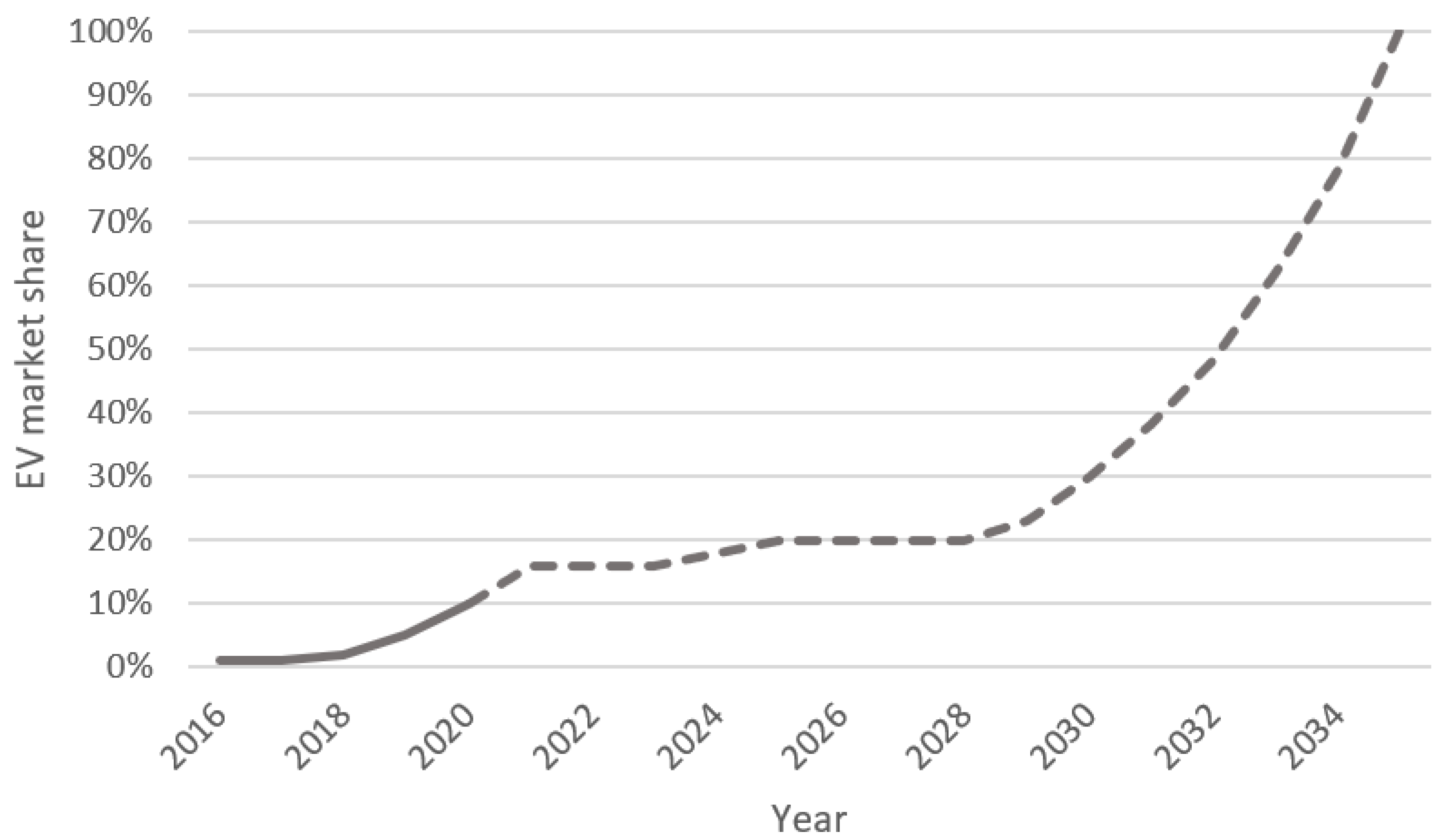

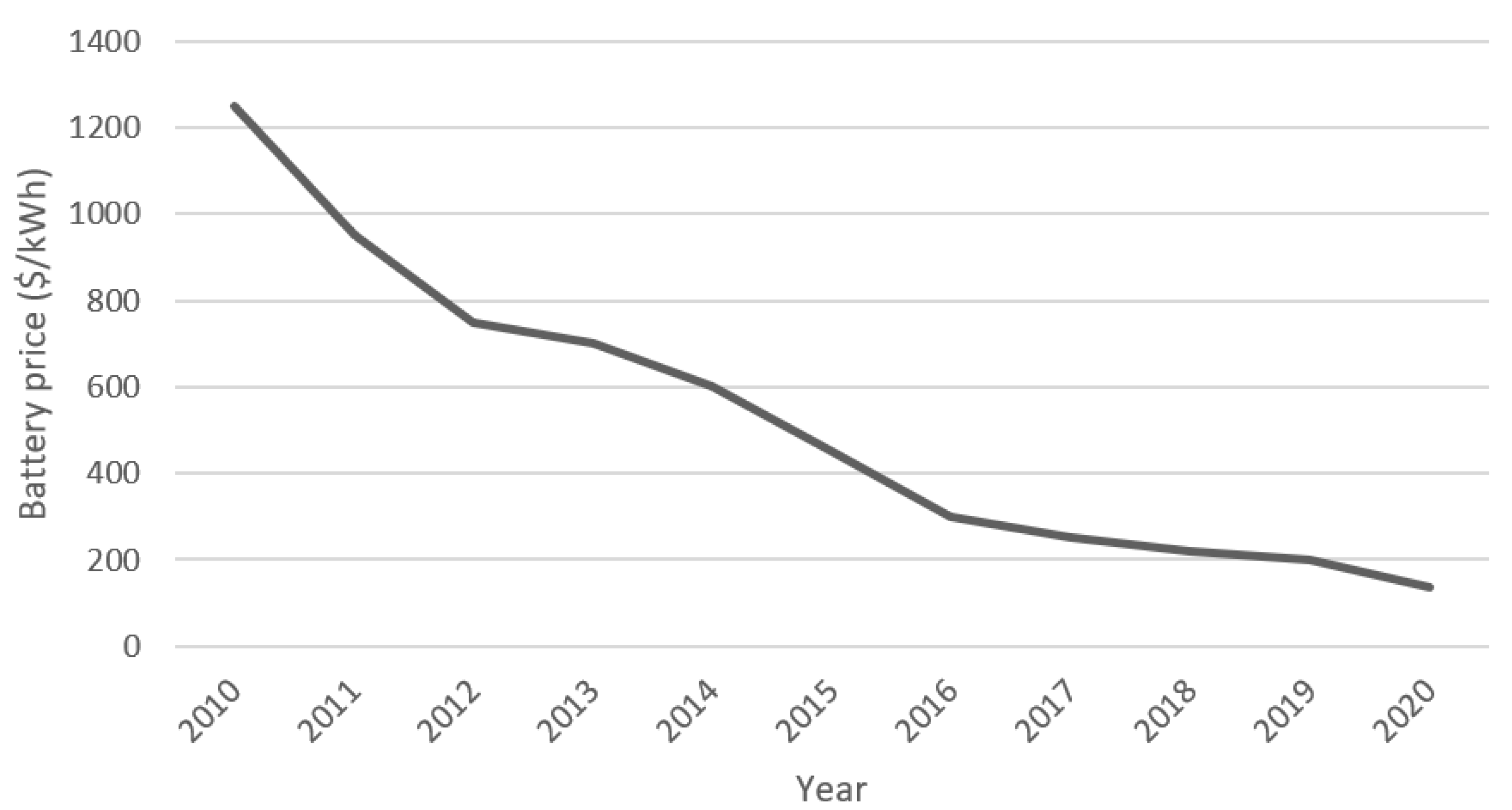
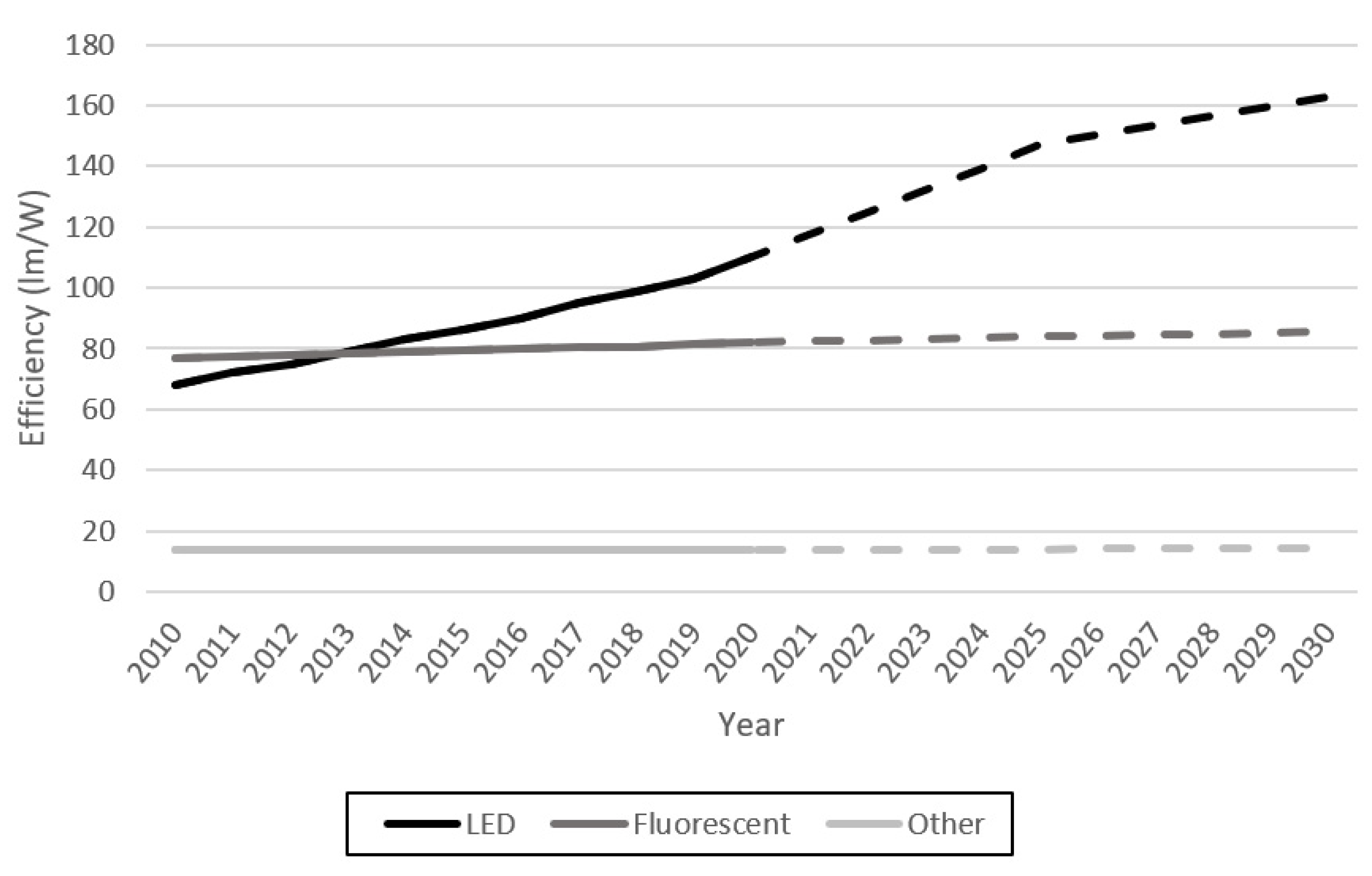
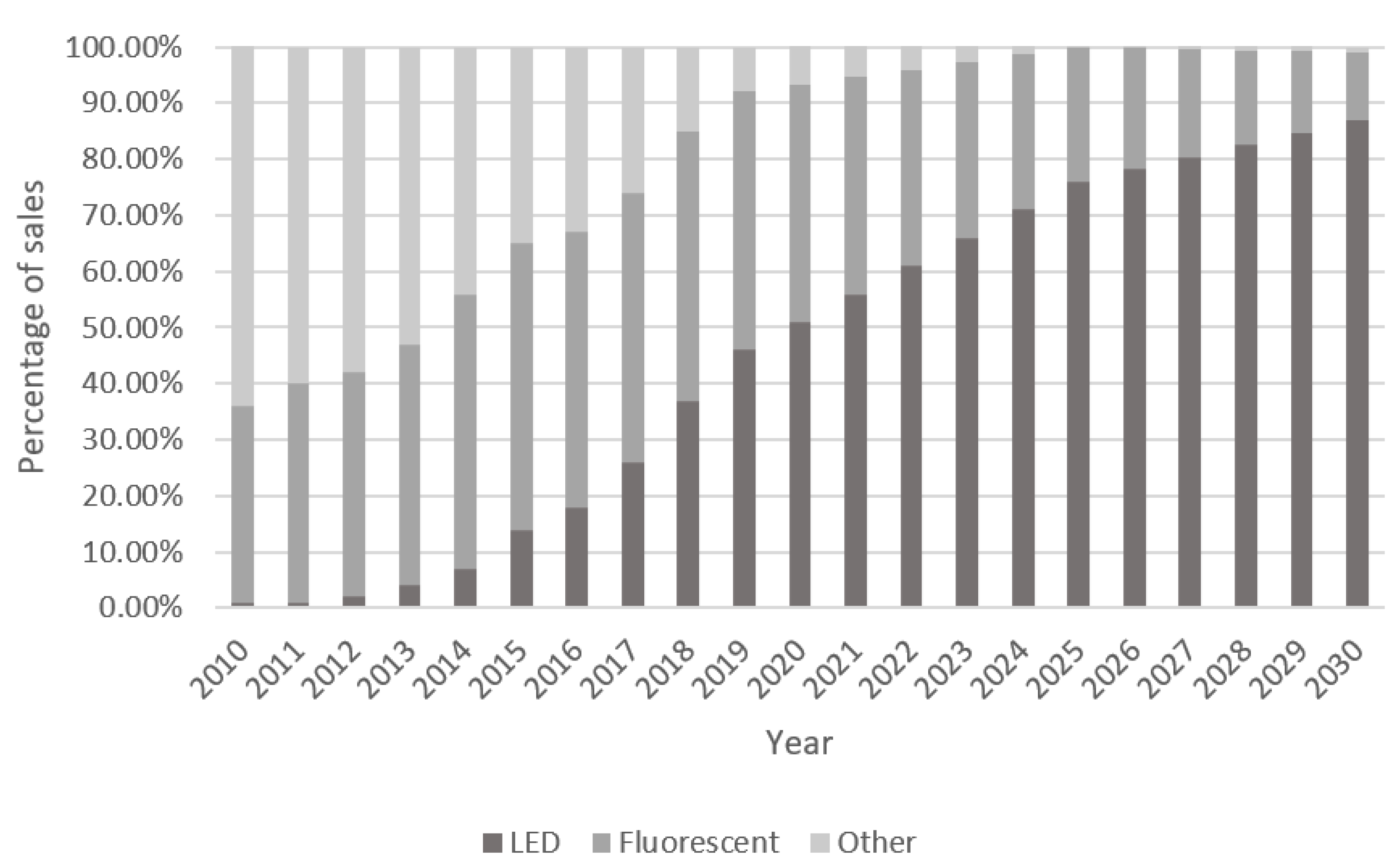
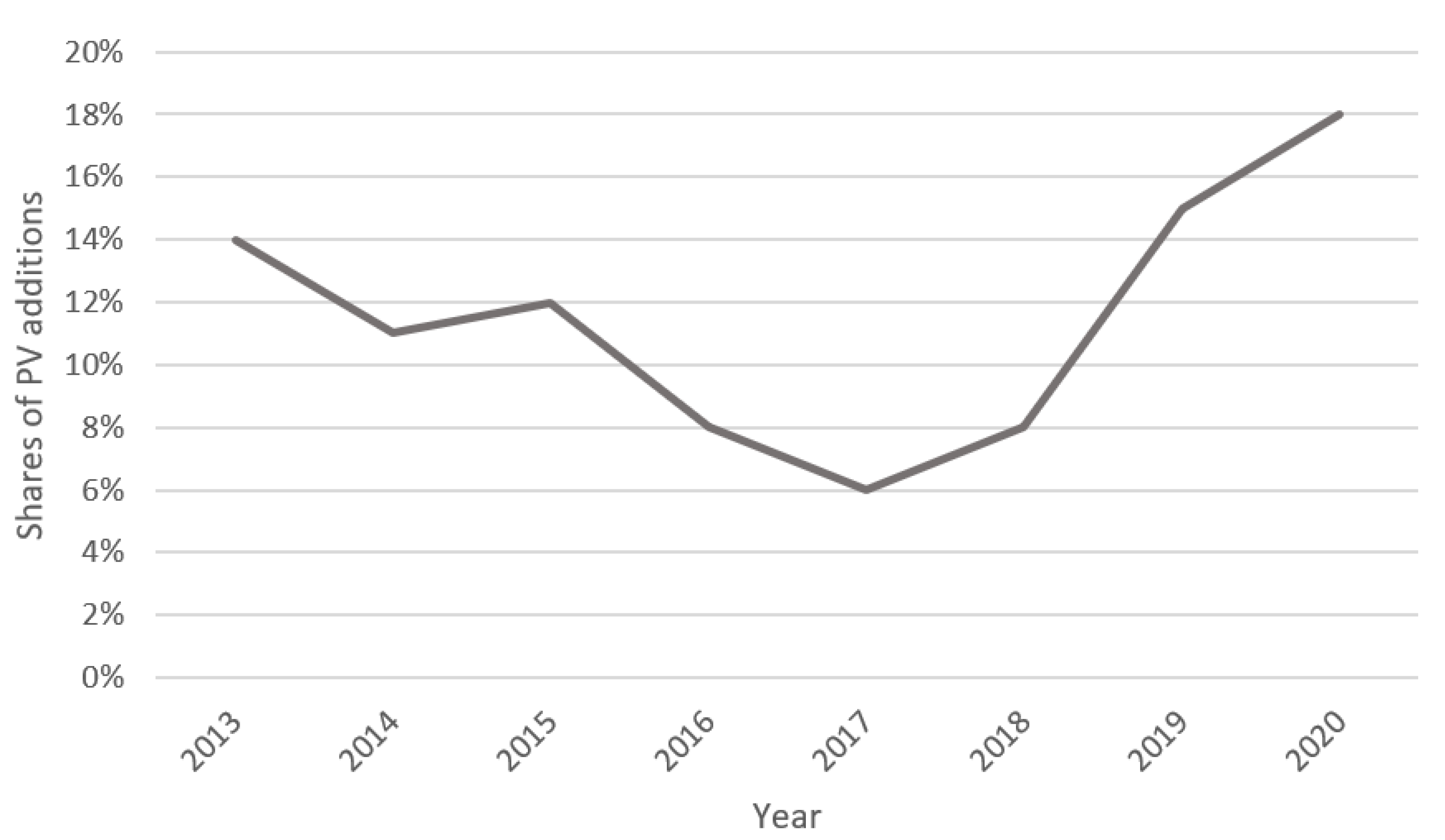
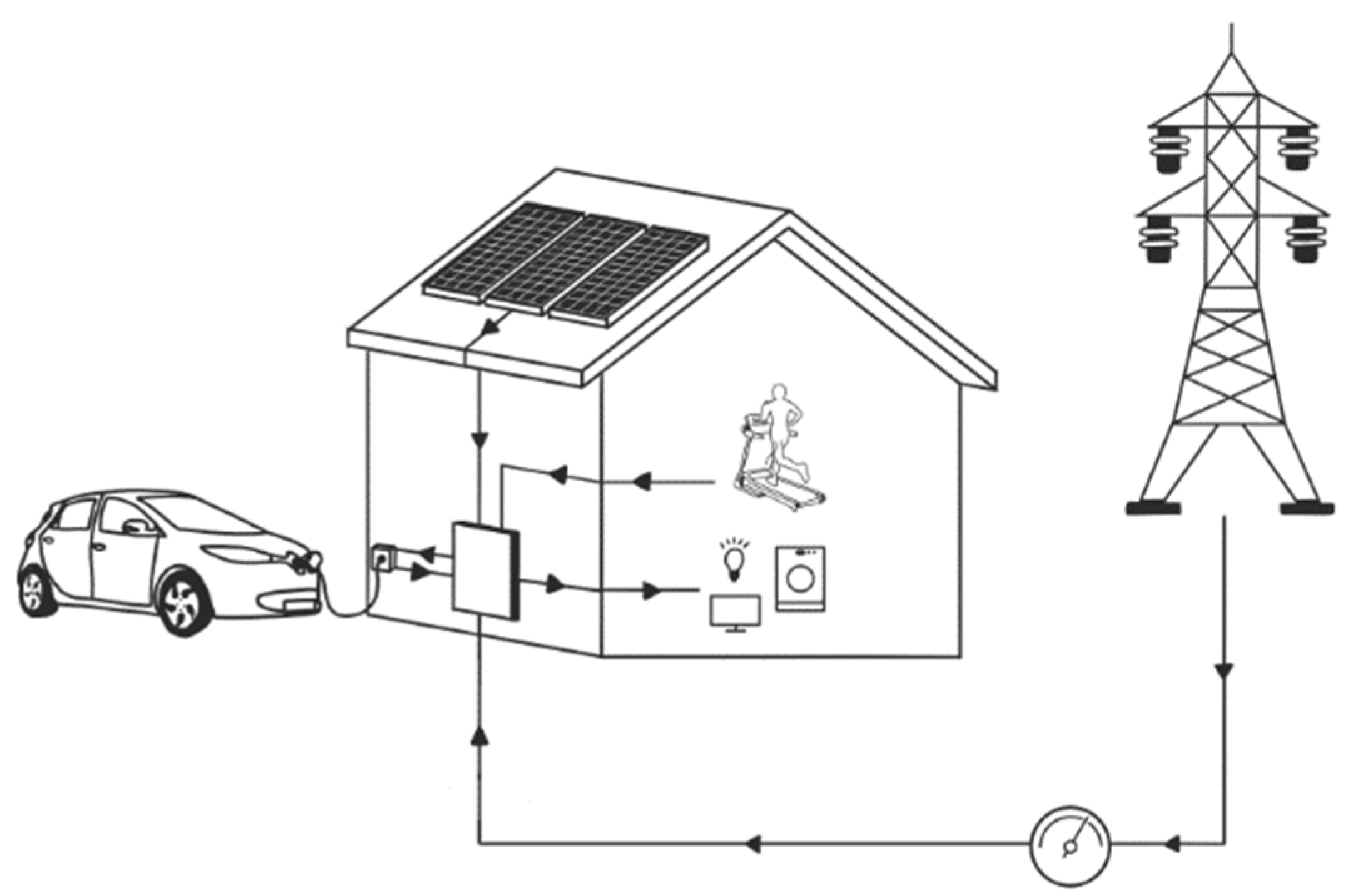
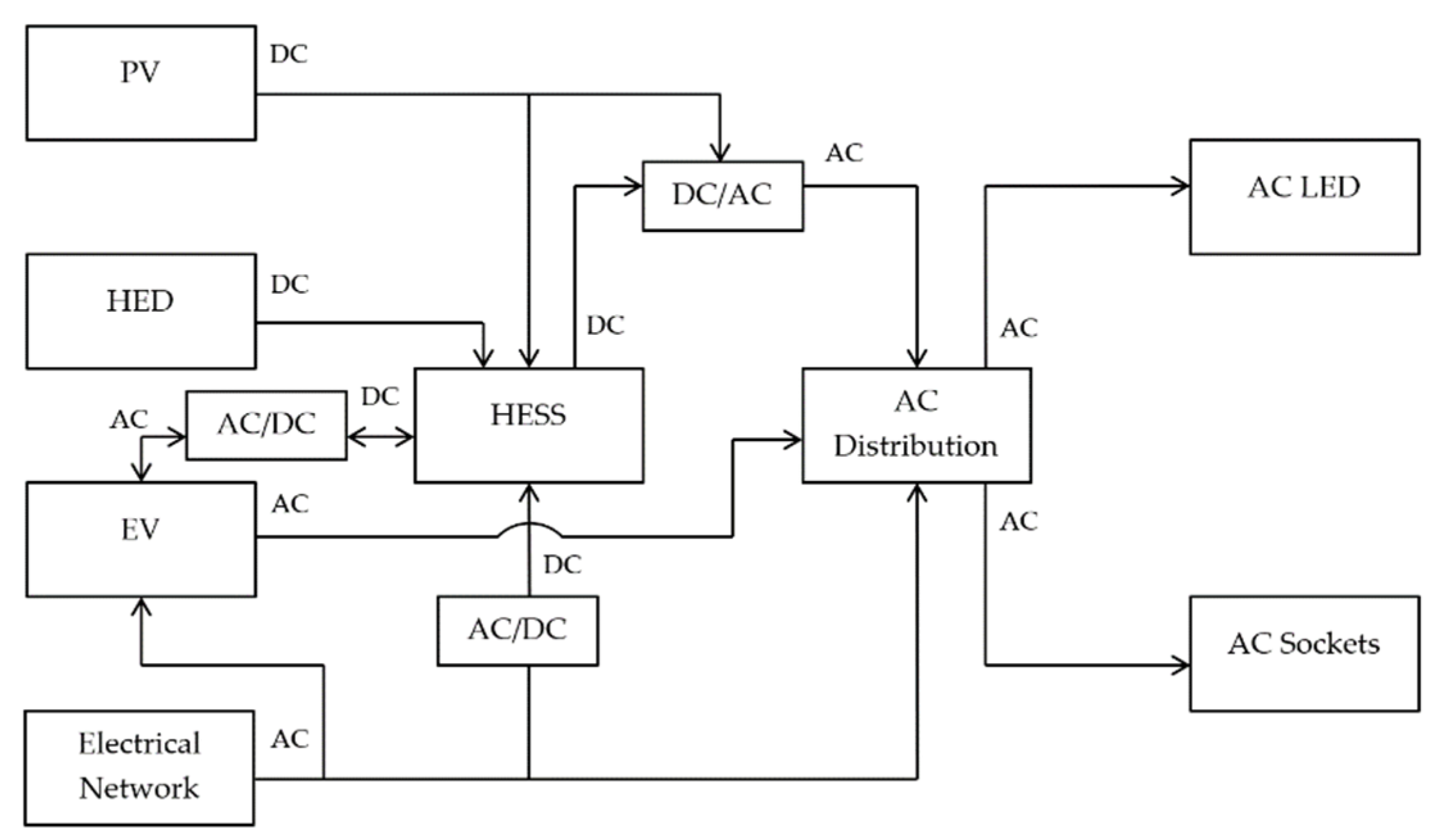
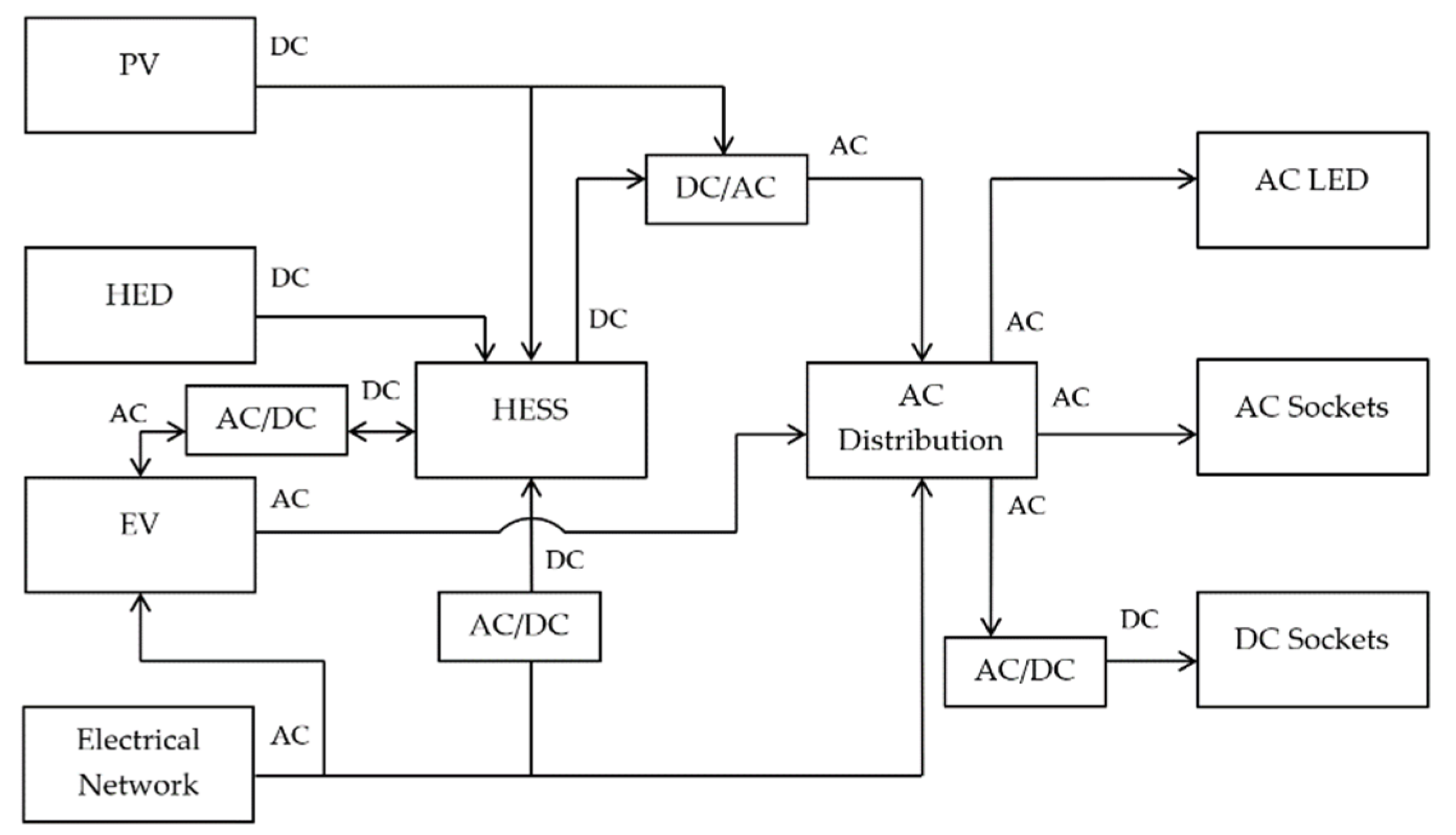
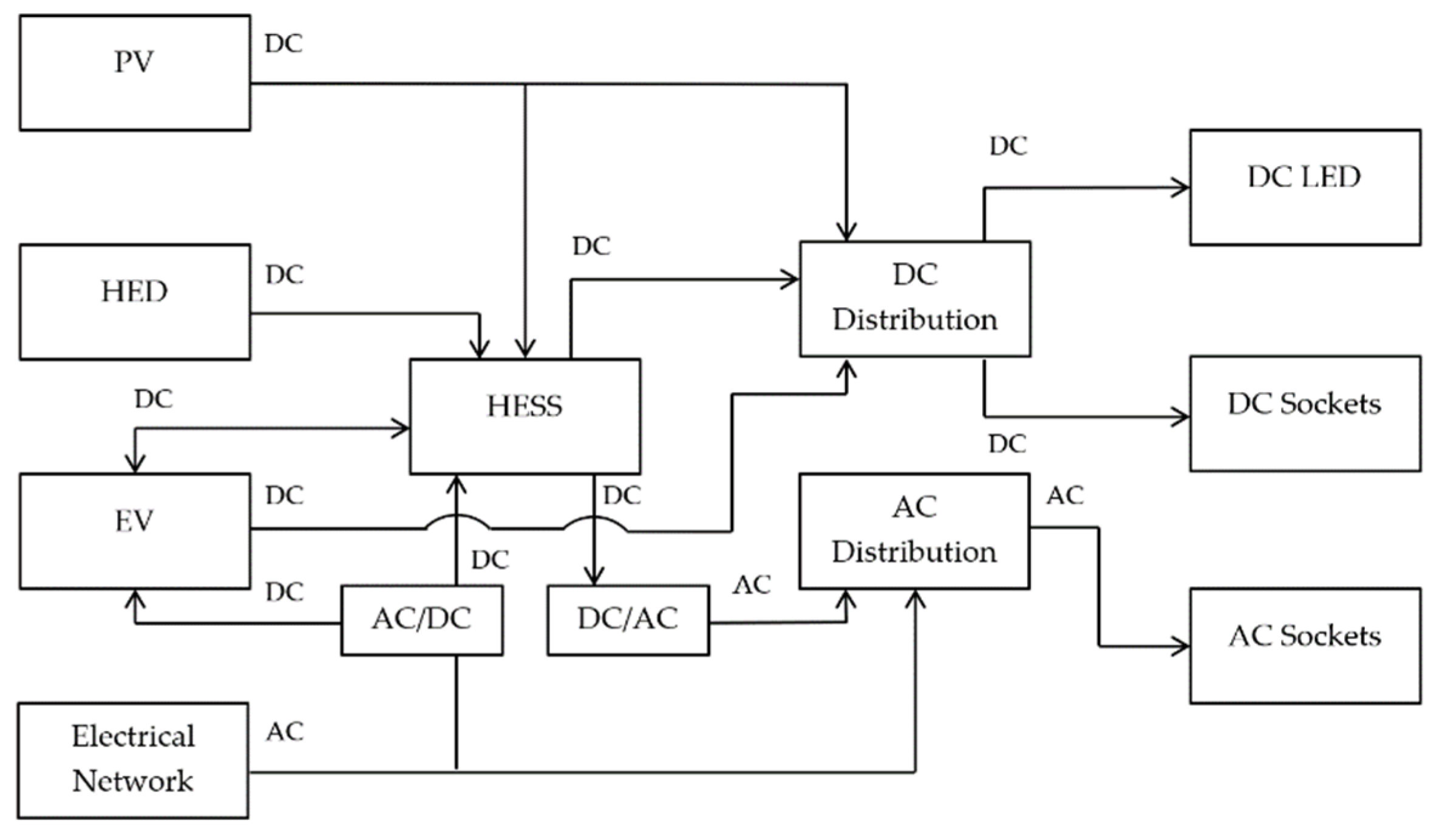
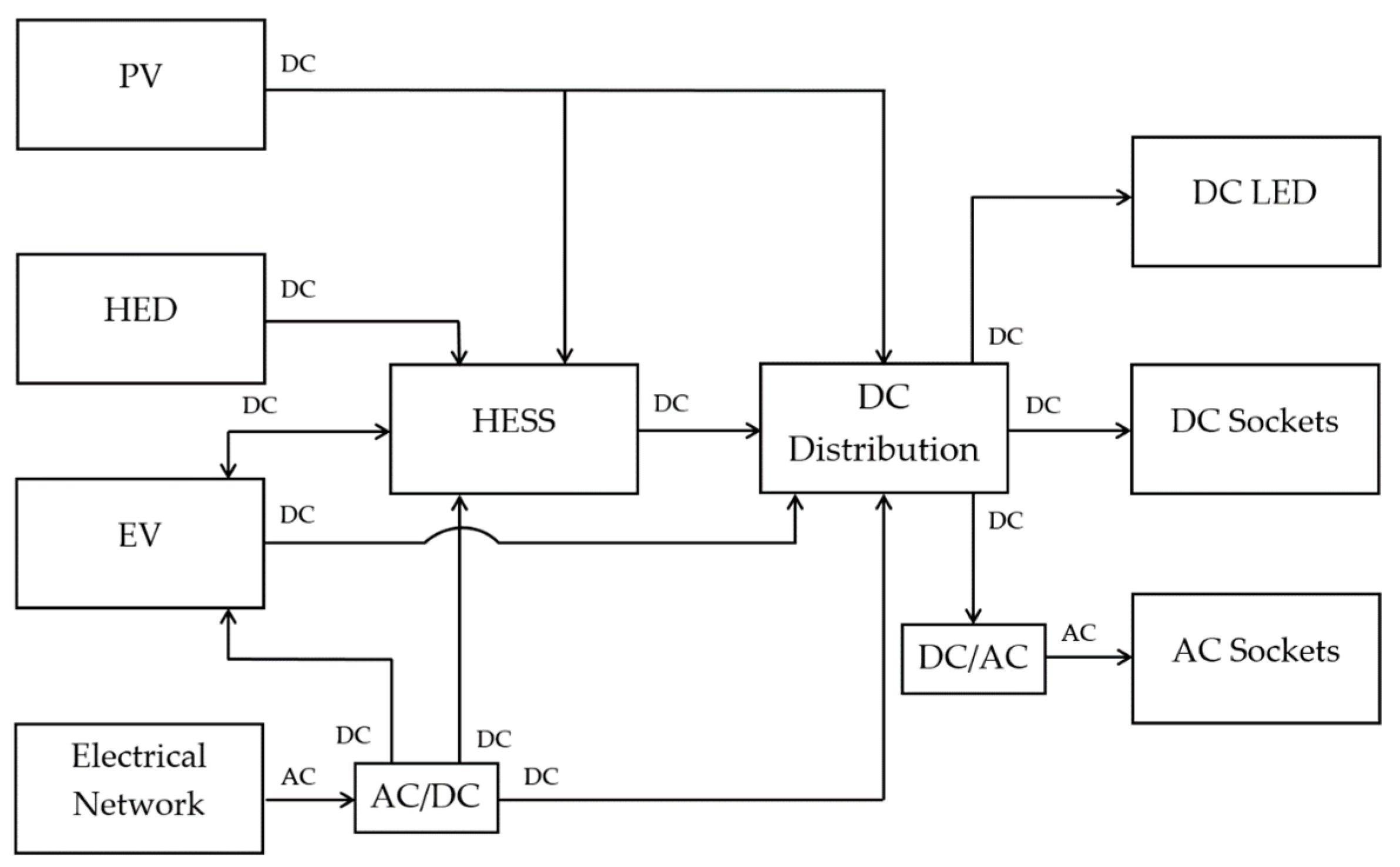
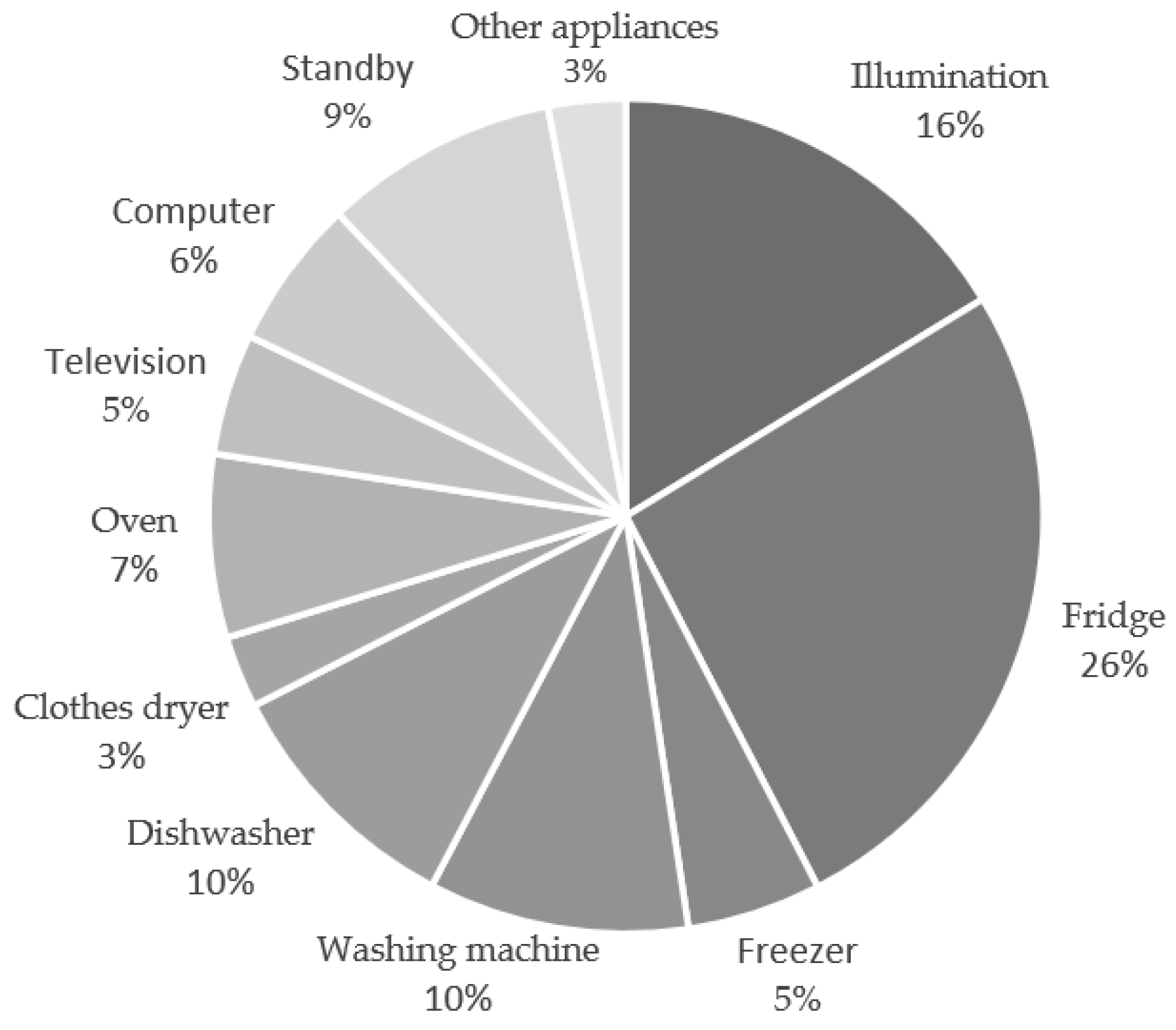
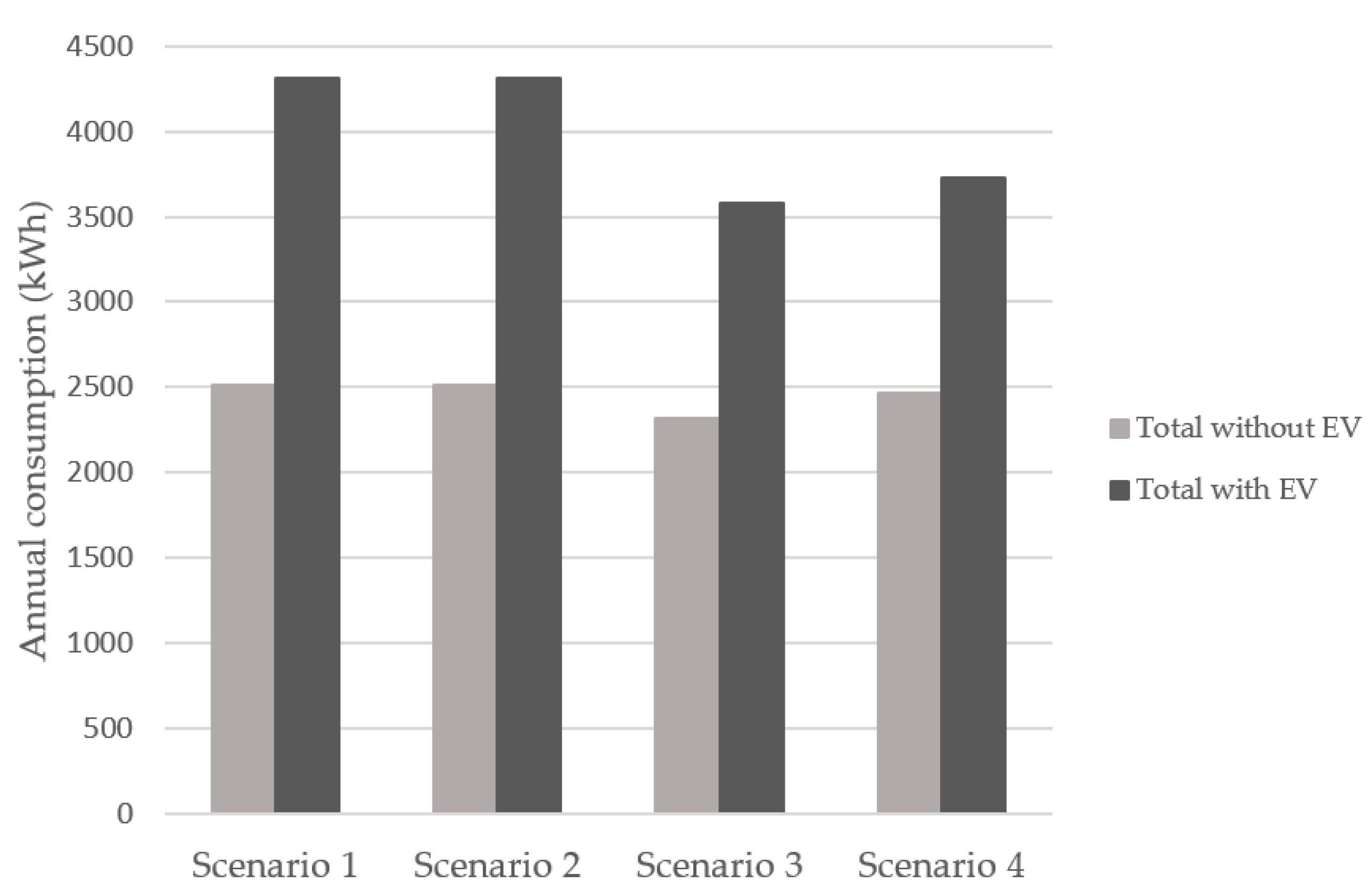
| Device | Motor | Power (W) | DC Version |
|---|---|---|---|
| Fridge/Freezer | YES 1 | 100 | YES |
| Illumination | NO | 7.5 | YES |
| Dishwasher | YES 1 | 2400 | NO |
| Washing Machine | YES 1 | 2300 | NO |
| Clothes Dryer | YES 1 | 2800 | NO |
| Telephone | NO | 0.7 | YES 3 |
| Router | NO | 12 | YES |
| Printer | NO | 210 | YES |
| Laptop | NO | 150 | YES 3 |
| Monitor | NO | 13.3 | YES |
| Desktop | NO | 310 | NO |
| Radio | NO | 10 | YES |
| Blue Ray | NO | 8.5 | YES |
| DVD | NO | 11 | YES |
| Game Console | NO | 350 | YES 3 |
| Set-Top Box | NO | 6 | YES |
| Television | NO | 183 | YES |
| Coffee Machine | YES 2 | 1100 | YES |
| Toaster | NO | 1090 | NO |
| Extractor Hood | YES 1 | 146 | YES |
| Oven | NO | 3600 | NO |
| Cooktop | NO | 6600 | NO |
| Microwaves | YES 2 | 1270 | YES |
| Air Conditioning | YES 1 | 5300 | YES |
| Water Heater | NO | 2000 | YES |
| Heating | YES 1 | 5600 | NO |
| Charger | NO | 18 | YES |
| Dehumidifier | YES 2 | 72 | YES |
| Hair Dryer | YES 2 | 2100 | YES |
| Hair Straightener | NO | 100 | NO |
| Iron | NO | 2800 | NO |
| Vacuum Cleaner | YES 2 | 2400 | YES 3 |
| Elec. Toothbrush | NO | 2000 | YES 3 |
| Device | AC/DC | Scenario 1 | Scenario 2 | Scenario 3 | Scenario 4 |
|---|---|---|---|---|---|
| EV | DC | 1800 | 1800 | 1260 | 1260 |
| Illumination | DC | 410 | 410 | 328 | 328 |
| Fridge | AC | 655 | 655 | 655 | 721 |
| Freezer | AC | 131 | 131 | 131 | 144 |
| Washing Machine | AC | 254 | 254 | 254 | 279 |
| Dishwasher | AC | 245 | 245 | 245 | 270 |
| Clothes Dryer | AC | 71 | 71 | 71 | 78 |
| Oven | AC | 178 | 178 | 178 | 195 |
| Television | DC | 119 | 119 | 95 | 95 |
| Computer | DC | 145 | 145 | 116 | 116 |
| Standby | DC | 229 | 229 | 183 | 183 |
| Other Appliances | DC | 75 | 75 | 60 | 60 |
| Total without EV | 2512 | 2512 | 2316 | 2469 | |
| Savings without EV | - | 0 | 196 | 43 | |
| Total with EV | 4312 | 4312 | 3576 | 3729 | |
| Savings with EV | - | 0 | 736 | 583 |
Publisher’s Note: MDPI stays neutral with regard to jurisdictional claims in published maps and institutional affiliations. |
© 2021 by the authors. Licensee MDPI, Basel, Switzerland. This article is an open access article distributed under the terms and conditions of the Creative Commons Attribution (CC BY) license (https://creativecommons.org/licenses/by/4.0/).
Share and Cite
Villanueva, D.; Cordeiro-Costas, M.; Feijóo-Lorenzo, A.E.; Fernández-Otero, A.; Miguez-García, E. Towards DC Energy Efficient Homes. Appl. Sci. 2021, 11, 6005. https://doi.org/10.3390/app11136005
Villanueva D, Cordeiro-Costas M, Feijóo-Lorenzo AE, Fernández-Otero A, Miguez-García E. Towards DC Energy Efficient Homes. Applied Sciences. 2021; 11(13):6005. https://doi.org/10.3390/app11136005
Chicago/Turabian StyleVillanueva, Daniel, Moisés Cordeiro-Costas, Andrés E. Feijóo-Lorenzo, Antonio Fernández-Otero, and Edelmiro Miguez-García. 2021. "Towards DC Energy Efficient Homes" Applied Sciences 11, no. 13: 6005. https://doi.org/10.3390/app11136005
APA StyleVillanueva, D., Cordeiro-Costas, M., Feijóo-Lorenzo, A. E., Fernández-Otero, A., & Miguez-García, E. (2021). Towards DC Energy Efficient Homes. Applied Sciences, 11(13), 6005. https://doi.org/10.3390/app11136005








